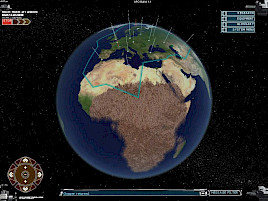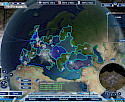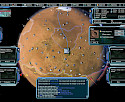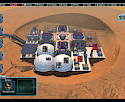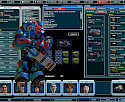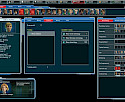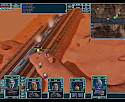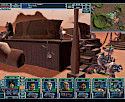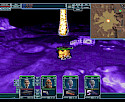UFO Afterlight Second Preview
Intro
In the closing days of 2006 I went to Mars.
It wasn't the present day Mars. It was a futuristic Mars in the years 2053-2054. Mankind was all but extinct and Earth had been rendered inhabitable by war with an alien race called the Reticulans. With the war being fought to a standstill the Reticulans gave mankind an offer which the Council of Earth accepted.
By accepting the Reticulans offer the remnants of mankind was moved of the surface Earth. Some were moved to a large orbiting city called the Laputa, and the rest was put in cryogenic sleep and transported to Mars. Since Mars was to become 'New Earth' for mankind it had to be terraformed so humans could live there. To accomplished this a few human scientists and technicians was assigned to terraform Mars with the help of the Reticulans.
The terraforming project was progressing very slowly over the next 50 years partly due to difficulties on Mars and partly due to interference from the Council of Earth. Loosing contact with the Laputa, the surviving humans suddenly found themselves alone at Mars with no way to contact the Council of Earth or the Reticulans. The death of one a founding members of the Martian colony did little to improve the situation. Someone or something had awoken and suddenly mankind's future on Mars didn't seem all that promising.
So after having spent the better part of a month on Mars I have returned to present day Earth to give you the a preview of ALTAR Games upcoming UFO: Afterlight.
Strategic
In UFO: Afterlight the geoscape serves as your main strategic interface. From the Geoscape you have access to all underlying interfaces like Base, Overview, Research, Production, People, Squads, Equipment, Diplomacy and the '?' which is the Encyclopedia. There are also a display showing your general resource situation and how hostile the planet is.
The geoscape graphics are visually pleasing represented by a very detailed model of Mars. This is where you will be making most of your strategic decisions. These strategic decisions include what territories to occupy, what missions to undertake and where to build off-base constructions like resource mines. Since these decisions have to be carried out by your people they need to the able to get around Mars. To get around Mars your people have different kinds of transports available; UFO and rovers. UFO is used to carry your soldier to the destination and back when on missions. Rovers are used to ferry your scientists and technical staff around Mars when working away from the base.
The Overview interface is where you get the big picture of everything. Territories, resources, personnel and mission statistic information are all available there. One nice feature is that if you click a territory the geoscape zoom in on the territory in question.
The Diplomacy interface is where you interact with the other factions/players in UFO: Afterlight. You can sue for peace, forge an alliance, trade resources/equipment, request reinforcements, give/request territory or break a treaty. All of the factions have an historic bond to either your faction or the others. This means you just can't befriend all of them, and I imagine it has quite an impact on the story.
In the Base interface you have a full 3d external view of your base. It is here you manage which base facility your people work in; a lab/scientific bay if it's scientific staff and a workshop/civil engineering/technical bay if it's technical staff. All base construction orders are issued here by placing the new building appropriately and assigning some technical staff to civil engineering.
The Research and Production interface pretty much work after the same concept. You assign people to a given workshop or lab and decide what that workshop or lab is to produce/research. The more people you assign the workshop or lab the faster it will complete its production/research cue. Different kinds of research/equipment specialists can speed up a given research or production if it is in their field of expertise. The '?' interface is the encyclopedia section where all researched topics are stored along with logs of story milestones. If you're ever in doubt as to what to research or manufacture then take a look around this section.
The Storage interface is where you get an overview of all of your equipment and loot. It is also here that you find the Compose interface where you can customize your equipment to give your soldiers an edge on the battlefield.
The Squad and Equipment interfaces are somewhat interconnected since they evolve around squad management. In the squad interface you assign persons to individual squads. One person may be a member of more then one squad. This allows you to customize a squad for any kind of mission.
The equipment customization happens in the equipment interface where you equip the individual soldier in that particular squad. This allows for the same person to have different kinds of equipment in different squads, or the same kind of equipment in different squads.
In the People interface you manage the training and leveling of your people. There are three classes of people; soldiers, scientists and technical staff. Soldiers are the only class that there can go on tactical missions. Scientists are responsible all research when in the base and occupying/claiming new territory when not. They do this by 'putting up the flag' and constructing scientific equipment in the captured territories. Technical staff is responsible for all manufacture of equipment as well as all construction jobs both in the base and at the surface on Mars.
Some missions do require that there is either a scientist or a technical staff along for the ride. To overcome this potential dilemma some of your personnel have two classes; soldier/scientist, soldier/technical staff or scientist/technical staff. Therefore some of your personnel can both work at the base and participate in the fighting. These dual class personnel have to be present at the base when the soldiers depart, and not out on the surface of Mars working.
What I like about this personnel management system is that a person doesn't have to be idle standing by to go fighting. They can do their thing either training, working in the workshop or researching in the lab and only be away from their thing for as long as the mission takes.
People of all three classes earn experience point when doing class related work. Thereby they gain levels and are given one training point per level. These training points can be used to specialize; heavy weapons operator/sniper for a soldier, expert at a certain area of research for a scientist or producing a certain type of equipment faster for technical staff.
Like the Base interface, the People interface can also be used to assign people to a specific facility. As the story progress you will be joined by more personnel including aliens and drones that each has their own tab in the People screen.
Tactical
Tactical missions are what I would consider the driving force behind any game in the UFO A-series. It's where territory are won or lost, it's where you get new material to research, and it's where your technical staff's prowess shines through by the quality and quantity of your equipment that you bring to bear on your enemies.
One major game play issue in the previous games has been mission load times. In short, they haven't been improved - the improvement is a couple of seconds at best. The load times has to do with the graphics in the tactical combat missions which is greatly improved over its predecessors.
One major factor that decides which missions you can undertake is how hostile the environment is in the mission area. Since your soldiers wear spacesuits they are protected from the hostile environment to a certain level. I would not advice any player to undertake a mission that has hostile environment over the spacesuits protection level. If you do you will have two choices: Get out of there (resulting in mission failure and the survival of your troops) or complete the mission quickly before your soldiers spacesuits fail (resulting in mission failure and the possible deaths or your soldiers). If a spacesuit fails its user will go unconscious and will remain that way until the mission is over or the spacesuit is repaired and its user is revived during the mission.
The generic mission types are search and destroy all units, destroy a certain object, kill certain units, bring one back alive and object retrieval missions. There are also special missions that will advance the story. The tactical environment now has three 'levels' which can be switched between to give you a better view of things if some of the environment is blocking your view.
The interface has been refined since UFO: Aftershock allowing for smoother tactical gameplay. The camera now allows for various view modes: Automatic, Free and Unit. Automatic is your standard setting for beginners. I found this camera mode not to my liking so I chose Free instead. Free is for the advanced player who like to have it his/hers way by having almost complete control. Unit allows you to see through the eyes of the selected unit which gives you that First Person Shooter feeling should you need it.
Your soldiers will at first only be able to stand and walk due to the restrictions of the spacesuits they must wear. But in time they will learn to crawl, couch, sneak and run with the right kind of training.
When you start the game you might find the AI to be 'stupid' as you just plow right through them with you superior firepower. But the playfield will be leveled as you get further into the game. I have experienced the following: Ambushed, nuked by out of sight grenade launchers, overwhelmed by far superior numbers, almost overrun and mind controlled. That is just some of the tactical gems that the AI has pulled from its bag of tricks while I was playing, and I'm sure there are many more.
Final thoughts
Even if I 'only' played a late preview version of the game, it is already a pretty good game with potential for old school UFO A-series gamers and newbies alike. When you play the game beware of the time. It will grab you by the family jewels and take you for a ride. The ride might get bumpy at times making you stop, but you'll be back soon enough wanting more.
February 9th is the official release date for UFO: Afterlight, and you can find a list of stores to preorder from here. All screenshots made playing the preview version can be downloaded from our files section (will contain spoilers!).


